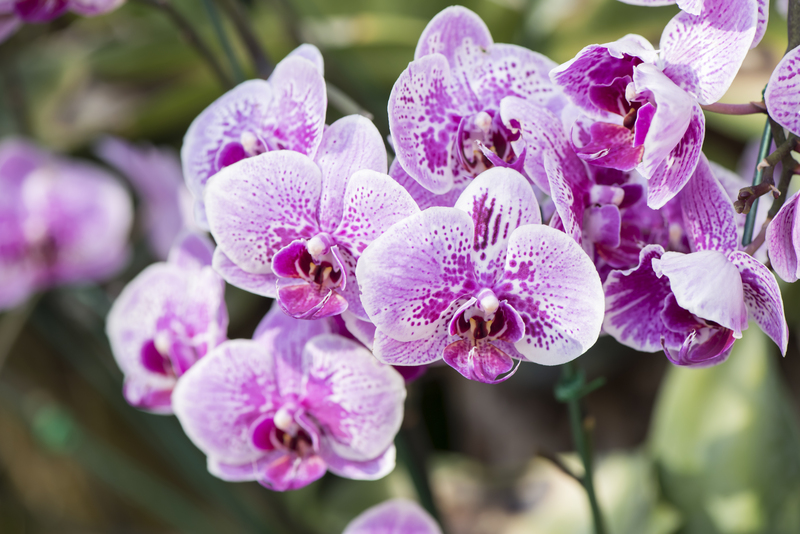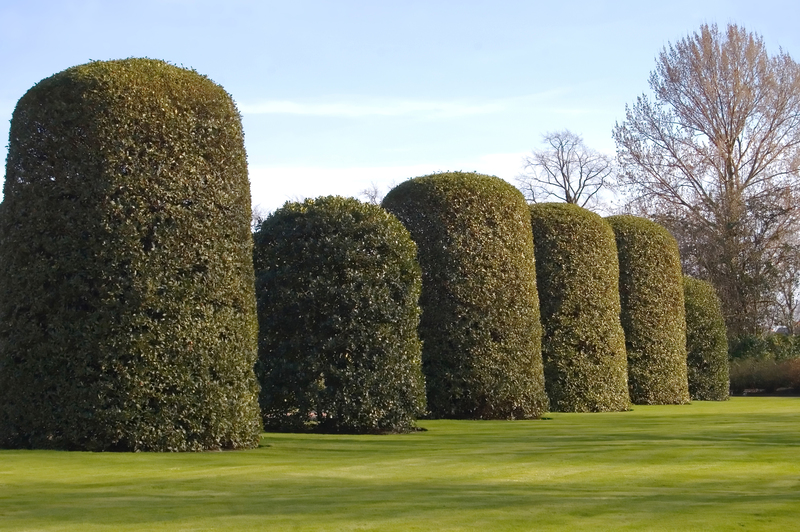Why container gardening is perfect for small spaces
Posted on 17/09/2025
Why Container Gardening Is Perfect for Small Spaces
If you live in a city apartment, a home with a tiny backyard, or simply want to brighten up your balcony, container gardening offers the perfect solution. Urban dwellers and those making the most out of their limited grounds have embraced the endless possibilities of growing plants in pots, baskets, and other containers. In this in-depth article, we'll explore why container gardening is ideal for small spaces, provide tips, advantages, and the many ways you can successfully transform even a tiny corner into a green oasis.
Understanding Container Gardening
Container gardening--sometimes called potted gardening or portable gardening--is the practice of growing plants in various containers instead of planting them directly in the ground. These containers can be pots, tubs, hanging baskets, window boxes, or even repurposed objects such as old buckets or boots. This style of gardening adapts perfectly to spaces where traditional gardening is impossible or impractical.
The Essentials of Container Gardening
- Using specifically chosen soil blends suited for limited spaces
- Careful watering and drainage management
- Strategic sunlight positioning
- Smart container selection for decorative and functional purposes

Advantages of Container Gardening for Small Spaces
Living with space constraints doesn't mean you have to give up your dreams of growing flowers, herbs, or even vegetables. Here are the top benefits of adopting container gardening for limited areas:
1. Maximizing Every Inch: Apt for Tiny Areas
Container gardens fit effortlessly onto balconies, patios, window sills, rooftops, and even walls. You can grow multiple plants vertically or horizontally. With just a few square feet--or even less--you can cultivate a vibrant oasis of colorful blooms, edible greens, or fragrant herbs. Every nook and cranny becomes an opportunity for growth.
2. Portable and Flexible Design
One of the strongest points of container gardening for small areas is its mobility. Are your plants not thriving in one spot? Move them! Need to clear the floor for a gathering or change your home's layout? Rearranging potted plants is a breeze. This flexibility is especially valuable to renters or anyone with a frequently shifting living space.
3. Customization and Personal Expression
From terracotta pots to colorful ceramic planters, baskets, or even upcycled containers, your garden design is only limited by your imagination. Container gardens enable you to enhance your decor, express your style, and create themed displays--like a collection of succulents, a kitchen herb garden, or a vertical jungle.
4. Control Over Soil and Pests
Planting in containers allows you to tailor the soil composition for each plant's needs. This is vital for species with specific requirements--like acid-loving blueberries or drought-tolerant succulents. In addition, containers act as a barrier against many soil-borne pests and diseases, saving you the headaches often encountered in traditional garden beds.
5. Easy Maintenance and Accessibility
Caring for a container garden is generally less demanding. Weeding is minimal, and fertilizing and watering can be more easily controlled. Raised planters or tabletop containers make maintenance comfortable for those with mobility issues or time constraints.
Best Plants for Container Gardening in Small Spaces
When space is at a premium, it's wise to pick plants that thrive in containers and don't require a lot of root space. Here are some top recommendations:
A. Edible Herbs & Vegetables
- o Basil, mint, parsley, chives
- o Cherry tomatoes, lettuce, spinach, radishes
- o Peppers, dwarf beans, compact carrot varieties
B. Flowering Plants
- o Marigolds, pansies, petunias, geraniums
- o Compact roses, begonias, lobelia
C. Succulents and Cacti
- o Aloe vera, jade plant, echeveria, haworthia
D. Houseplants and Foliage
- o Snake plant, pothos, spider plant, peace lily
- o Ferns, palms, calathea
Tip: Look for dwarf or mini cultivars bred especially for pots. Many seeds and plant labels now indicate which varieties are best for container garden setups.
How to Start a Container Garden in a Small Space
Ready to create your own container garden on a balcony or patio? Follow these essential steps to maximize your chances of success and enjoyment:
1. Choose the Right Containers
- Size: Select containers large enough for the mature plant's root system.
- Material: Consider terracotta (breathable), plastic (lightweight), ceramic (decorative), or recycled vessels.
- Drainage: Always ensure there are drainage holes at the bottom--waterlogged roots cause most plant deaths.
2. Select Quality Soil
- Use a potting mix specifically formulated for containers--never use regular garden soil, which can compact and drown roots.
- Choose a mix that matches your plant selection (e.g., cactus mix for succulents, acidic soil for azaleas).
3. Plan for Sunlight
- Evaluate your available space throughout the day.
- Most veggies and flowering plants need at least 6 hours of direct sun; others thrive in partial shade.
- Move containers strategically to capture changing patterns of light.
4. Watering Techniques
- Containers tend to dry out faster than ground soil; check moisture daily--especially in hot weather.
- Use self-watering pots or drip irrigation systems (even in small setups!) to reduce effort.
- Don't forget to fertilize--the limited soil dries out nutrients quickly.
5. Arrangement and Style
- Group containers for impact, combining plants with similar water and light needs.
- Use shelves, racks, or hanging baskets to build up instead of out--a vertical container garden multiplies your greenery!
- Experiment with color, texture, and height for a dynamic display.
Creative Container Gardening Ideas for Small Spaces
The beauty of container gardening for apartments and limited outdoor space is its unlimited adaptability. Here are some inspirational ideas to get you started:
- Vertical wall gardens: Mount pots or pocket planters on fences, walls, or trellises.
- Hanging baskets: Suspend baskets from hooks or railings for a cascading effect.
- Window boxes: Perfect for flowering displays or culinary herbs within arm's reach of the kitchen.
- Tiered plant stands: Stack multiple levels for maximum variety without using more floor space.
- Repurposed containers: Upcycle everything from rain boots to old teapots for quirky charm.
Common Challenges and Solutions in Small Space Container Gardening
While container gardening in restricted areas is rewarding, a few challenges can arise -- but all have simple fixes:
Limited Sunlight
- Use mirrors, light-colored surfaces, or reflective mulch to amplify available sunlight.
- Choose shade-tolerant plants if light is limited.
Drying Soil
- Mulch the surface with pebbles or bark to conserve moisture.
- Opt for self-watering containers or add water-retaining crystals to the soil mix.
Overcrowding Plants
- Be mindful of plant spacing; overcrowding leads to poor air circulation and disease.
- Prune regularly and re-pot as needed.
Weight Restrictions
- If gardening on a balcony or fragile surface, use lightweight containers and soil mixes.
- Consult your building management for load-bearing limits.
Sustainable Practices in Container Gardening
One of the eco-friendly benefits of container gardening for small homes is the ability to grow your own food and beautify your surroundings with minimal resources. Explore sustainable approaches such as:
- Composting kitchen scraps directly in containers (vermicomposting is space-friendly!).
- Using organic fertilizers and pesticides to protect pollinators and beneficial insects.
- Collecting rainwater in small barrels or buckets for irrigation.
- Choosing native plants that thrive with less water and maintenance.
- Repurposing and recycling containers to reduce waste and add personal flair.

Frequently Asked Questions (FAQ) About Container Gardening in Small Spaces
Can I grow vegetables in containers if my balcony gets little sunlight?
Yes! While fruiting veggies like tomatoes need lots of sun, many leafy greens (lettuce, spinach, arugula) and herbs thrive with as little as 3-4 hours of sunlight daily.
How often should I water my container plants?
It depends on plant type, weather, and container size. Generally, check soil daily with your finger--water when the top inch feels dry. Smaller pots dry out faster.
Is it expensive to start a container garden?
No! Start small with reused or inexpensive containers and gradually add more as you gain confidence. Many supplies can be found at thrift stores or repurposed from household items.
Conclusion: Embrace the Potential of Container Gardening for Your Small Space
Container gardening is a solution tailor-made for urban living and homes with limited outdoor access. Its adaptability, aesthetic possibilities, and low entry barrier allow anyone to reap the benefits of gardening, regardless of space. Whether you long for fresh homegrown vegetables, a burst of floral color, or a calming green retreat, gardening in containers unlocks a world of opportunity on your doorstep, windowsill, or balcony rail.
With a little creativity and care, you'll find that container gardening for small spaces is not just possible--it's endlessly rewarding. Why not start today and nurture your own miniature paradise, no matter where you live?

